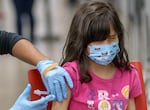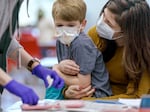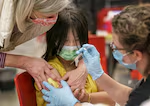Enrique Campos did not want a shot. The shaggy haired boy wailed in his mother’s arms while she calmly rubbed his shoulder and murmured into his hair.
After the nurse at the free vaccination clinic in East Portland finished checking and double checking that he had the right shot and the right arm, the needle went in. Told it was over, Enrique, 7, stopped crying. His sisters clapped. The boy looked up sheepishly, his face streaked with tears. The anticipation had been worse than the pinch.
“Like any mom — we want the best for them,” his mother, Loren Campos, said later, speaking in Spanish. “You try to relax him, that’s the only thing you can do. Hug him, that’s the only thing.”
The family had been vaccinated in El Salvador, where they lived until a few months ago, but there weren’t as many required shots there, Campos said. When they got to Portland, she realized her kids had to catch up.
“I need to get it now or I am not going to [go to] school,” said Miranda Campos, 9. That was reason enough for the self-possessed Ainsworth Elementary student to get her shots — all three of them — without complaint.
“It’s normal to be scared of vaccines,” she said. To stay calm, she thinks kids should copy her. She takes a deep breath and closes her eyes “and I think something happy.”

Miranda Campos, 9, closes her eyes as she receives an immunization at a catch-up vaccination clinic held at McDaniel High School in Northeast Portland on Feb. 8, 2023.
Kristyna Wentz-Graff / OPB
The Campos family is among the approximately 5,600 families who received a letter from Multnomah County last week advising them that they had until Feb. 15 to either get their required vaccines or file for an exemption.
More than 26,000 such letters also went out across the state in February 2022, according to the most recent statewide data. Children who do not have either an exemption or a record of up-to-date immunizations will be excluded from school. Last year, more than 5,000 kids attending schools and child care programs were sent home on “exclusion day.” To be allowed back, they had to either get their required shots or file an exemption.
Clinics like the one at McDaniel High School, which was put on by the Multnomah County Health Department, the Multnomah County Education Service District and Portland Public Schools on Wednesday night, are one way the state is trying to help kids get vaccinated and keep learning. More vaccine appointments and clinics are available throughout the state this weekend and next week.
Oregon’s kindergarten-age vaccination rate lags behind the national average of 93%, which is also not high enough, said Shannon Stokley, deputy director for science implementation of the Centers for Disease Control’s immunization services division. The national goal is 95%, a rate that had been achieved in 2019, but has slipped by two percentage points, or about 76,000 kindergartners, since the pandemic.
While it’s good news that more than 9 out of 10 American kids are vaccinated, “we can’t go any lower,” Stokley said. “We have to do everything in our power to get back on track.”
Oregon hasn’t been at the 95% rate since 1998. And even though the overall rate here has ticked up since a low in 2020, just 88.7% of Oregon kindergartners had all their required vaccines in the 2021-22 school year, according to the Oregon Health Authority.

Vaccines at a pop-up clinic held at McDaniel High School in Northeast Portland, Feb. 8, 2023. The catch-up vaccination clinic, offered in conjunction with Portland Public Schools and Multnomah County’s Education Service District, aimed to provide childhood vaccines for youth 5-19, before the immunization deadline in the schools.
Kristyna Wentz-Graff / OPB
Access is one problem in Oregon, especially for the state’s communities of color, according to Jazmine Bowles, a consulting nurse who helped start Multnomah County’s vaccination program during the pandemic. Gaining trust means spending a lot of time working in those communities and providing health education, she said.
“We also see this mistrust of the health care system,” Bowles said. “And so we want to make sure that when we’re doing our health education, that we’re inviting people to not only be vaccinated, but just to learn information around vaccines and your health in general.”
Loren Campos, who is new to the country and primarily speaks Spanish, is just the kind of parent Bowles is most interested in reaching. Campos said it was very easy to show up, sign in, and get the necessary shots for her three children at the free clinic. Her older daughter, 16, helped by communicating with the school and medical staff, though there were professional translators for several languages on hand as well.
And they didn’t owe anything for the shots. Childhood vaccines are covered by federal funding for anyone who is uninsured, under-insured or on the Oregon Health Plan. Those free shots can be accessed at many pediatric practices and county health offices. As many as 50% of kids are eligible for the free shots under the federal program.
A lot of parents in Oregon aren’t sold on the idea of childhood vaccines, regardless of ease of access. Oregon has the third highest rate of exemptions — 7% — in the country, according to CDC data. Only Idaho and Utah had more. Most of Oregon’s exemptions are nonmedical, meaning parents have opted not to vaccinate for religious or other personal reasons.
Madison James used to be one of those parents. She lived in Washington when her three kids were born and because they were homeschooled initially, the family didn’t come up against Washington’s school vaccination requirements. But a few years ago, James found herself in need of a steady job that could provide for herself and her kids. She started taking prerequisites for nursing school. In her microbiology course, she learned how vaccines worked.
“I understood a little bit more about how viruses work and how specifically immunizations interact with them…and how your body remembers and recognizes things and understanding that vaccinations usually don’t have the live version right in them to where you can get sick from it,” James said. “And then I was like, ‘Oh!’ I understood it differently and felt totally different. So from that point forward I was like, ‘OK, let’s get the kids caught up.’”

Clive James-May, 6, is comforted by his mother, Madison James, as they attend a vaccination clinic at McDaniel High School in Northeast Portland on Feb. 8, 2023.
Kristyna Wentz-Graff / OPB
That’s what she did on Wednesday night, sitting patiently with each fretful child while they got their shots. She appreciated that checking in was simple and didn’t require an ID or proof of insurance. There were school officials on hand to confirm which shots each child needed. And the doses were free. While they waited the 15 minutes afterward to ensure no allergic reactions, Isla, 9, worked on a coloring book page featuring two sister princesses, Clive, 6, ate goldfish and Beau, 4, watched the newest Buzz Lightyear film playing on the big screen at the front of the cafeteria.
Standing nearby, James said she now thinks everyone should get their kids vaccinated. For those who are hesitant, she advises speaking to a nurse or doctor they trust and asking lots of questions.
Dr. Ann Loeffler, a deputy health officer for Multnomah County, said she knows vaccines work partly because she’s seen the effect they can have. In her early days as a hospital doctor, she said they were always caring for children seriously ill with haemophilus influenzae type B, more commonly known as Hib.
In the early 1980s, it’s estimated that 20,000 people a year were contracting Hib nationally, most children younger than 5, according to the CDC. The first vaccine was licensed in 1985 and a second in 1987, just as Loeffler was finishing medical school. A decade later, between 1997 and 2018, just 36 cases of the disease were reported in American children under 5.
These days, Loeffler said they see maybe one case of Hib or other diseases with relatively recent vaccines, like meningitis, every three years.
Having available vaccines doesn’t usually eliminate the diseases they prevent. And those who are unvaccinated by choice or who can’t be vaccinated for medical reasons are still at risk.
“I’ve seen babies die of whooping cough, which is completely preventable by our vaccines,” Loeffler said. “You can tell by my gray hair, I’m not young and I’ve taken care of scores of children deathly ill in the hospital with vaccine preventable diseases.”
She said no parent in those hospital rooms ever told her they understood the chance they were taking: “They always say ‘I did not know this could happen.’”
And that’s why she thinks parents should be informed about the benefits of vaccines long before a child ends up in the hospital, sick with a scary disease that could have been prevented. Guilt and fear are not the tools that work best to convince hesitant parents, Loeffler said.
She said it works better to explain the good things about vaccines — how they prevent thousands of deaths every year and will help children stay healthy — and to be honest about possible side effects. Hospitals and pediatricians in Oregon have information sheets for parents on all required childhood vaccines that explain the disease, the type of vaccine and possible side effects.
She thinks government vaccine mandates help ensure people get vaccinated, but she wishes that extra push wasn’t necessary.
“I believe in free will,” she said, “but I also have looked at a lot of data. I wish everyone would be able to get the information that they would feel like they could weigh the risks and benefits for their child’s health and that they’d be comfortable, but that’s not where we’re at in our society.”

Kelly Leung, 11, center, is reassured by Multnomah County Deputy Health Officer Dr. Ann Loeffler, left, and Sarah Roy, RN, as Leung receives vaccinations at McDaniel High School in Northeast Portland on Feb. 8, 2023.
Kristyna Wentz-Graff / OPB
By 6 p.m. on Wednesday evening, the East Portland clinic was closing down. Nearly 70 people, mostly children, had been vaccinated. Just a few last families were waiting their turn to see a volunteer nurse or doctor who would administer their shots. Loeffler was going through her routine one last time — check the label, prep the needle, ready the bandages.
The patient in front of her was a 15-month-old in pastel pink fleece pants. Her mother cradled her snugly as Loeffler leaned in to administer the first shot. This one was to protect against polio — a crippling disease that vaccines had eliminated in the U.S., until a case showed up in New York in 2022.
The shot went in, and the little girl’s eyes went wide, though she stayed calm. On the second shot, delivered under the skin rather than in the muscle, she started bawling. Her mom held her tight. After her older sister survived the same gauntlet, this time on dad’s lap, the family got ready to go home, sorting vaccination paperwork into a plastic folder of important documents.
Loeffler smiled at them and gave a compliment for bravery. But she wasn’t praising the kids; she was talking to their parents.
